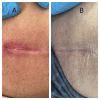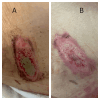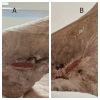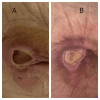Topical Application of Magnetized Saline Water Hydrogel Promotes Rapid Pressure Ulcer Healing in Hospitalized Elderly Patients: An Acute Care Case Series
- PMID: 40772181
- PMCID: PMC12326514
- DOI: 10.7759/cureus.87421
Topical Application of Magnetized Saline Water Hydrogel Promotes Rapid Pressure Ulcer Healing in Hospitalized Elderly Patients: An Acute Care Case Series
Abstract
Pressure ulcers, particularly among elderly patients with acute medical conditions, represent a significant clinical challenge and are associated with substantial morbidity and healthcare resource utilization. Autophagy, a fundamental cellular pathway involved in protein and organelle degradation, has emerged as a critical regulator of tissue repair and wound healing by orchestrating inflammatory cell activation, extracellular matrix deposition, and keratinocyte proliferation and differentiation. Topical application of magnetized saline water (MSW) may increase the expression of autophagy biomarkers in skin tissue, representing a potentially efficacious management strategy for wound care. We conducted a prospective observational case series to explore the clinical utility of a topical hydrogel containing 95% MSW in the management of stage 2‒3 pressure ulcers in elderly patients admitted to an acute medical unit. Five geriatric inpatients (age range: 75-93 years) who developed hospital-acquired pressure ulcers during acute care hospitalization were included in the study. Following standard wound cleaning protocols, the topical MSW hydrogel was applied daily to the affected areas. Wound healing progression was monitored via clinical photography, assessment of granulation tissue formation, and documentation of any adverse events. All patients exhibited effective wound healing, with clear clinical improvement observed as early as three days and up to 10 days following initiation of hydrogel application. Notable findings included granulation tissue formation, enhanced wound bed vascularization, progressive wound margin contraction, and active epithelial advancement. Intriguingly, these favorable outcomes were achieved despite the presence of severe comorbidities, including acute heart failure, pneumonia, and multi-organ dysfunction, which are typically associated with impaired wound healing in the elderly population. No adverse reactions related to the hydrogel application were evident. In summary, the findings from this case series suggest that an MSW-based hydrogel capable of stimulating autophagy may represent a promising therapeutic strategy for the management of pressure ulcers in acutely ill elderly patients. Further controlled studies are warranted to confirm these preliminary observations and to establish the role of MSW-based preparations within the broader context of wound care in geriatric medicine.
Keywords: acute care; autophagy; elderly; hospitalization; magnetized water; pressure ulcers; wound care.
Copyright © 2025, Ghidinelli et al.
Conflict of interest statement
Human subjects: Informed consent for treatment and open access publication was obtained or waived by all participants in this study. Conflicts of interest: In compliance with the ICMJE uniform disclosure form, all authors declare the following: Payment/services info: All authors have declared that no financial support was received from any organization for the submitted work. Financial relationships: All authors have declared that they have no financial relationships at present or within the previous three years with any organizations that might have an interest in the submitted work. Other relationships: All authors have declared that there are no other relationships or activities that could appear to have influenced the submitted work.
Figures





Similar articles
-
Dressings and topical agents for treating pressure ulcers.Cochrane Database Syst Rev. 2017 Jun 22;6(6):CD011947. doi: 10.1002/14651858.CD011947.pub2. Cochrane Database Syst Rev. 2017. PMID: 28639707 Free PMC article.
-
Foam dressings for treating pressure ulcers.Cochrane Database Syst Rev. 2017 Oct 12;10(10):CD011332. doi: 10.1002/14651858.CD011332.pub2. Cochrane Database Syst Rev. 2017. PMID: 29025198 Free PMC article.
-
Antibiotics and antiseptics for venous leg ulcers.Cochrane Database Syst Rev. 2013 Dec 23;(12):CD003557. doi: 10.1002/14651858.CD003557.pub4. Cochrane Database Syst Rev. 2013. Update in: Cochrane Database Syst Rev. 2014 Jan 10;(1):CD003557. doi: 10.1002/14651858.CD003557.pub5. PMID: 24363048 Updated.
-
Topical antimicrobial agents for treating foot ulcers in people with diabetes.Cochrane Database Syst Rev. 2017 Jun 14;6(6):CD011038. doi: 10.1002/14651858.CD011038.pub2. Cochrane Database Syst Rev. 2017. PMID: 28613416 Free PMC article.
-
Dressings and topical agents for the management of open wounds after surgical treatment for sacrococcygeal pilonidal sinus.Cochrane Database Syst Rev. 2022 May 20;5(5):CD013439. doi: 10.1002/14651858.CD013439.pub2. Cochrane Database Syst Rev. 2022. PMID: 35593897 Free PMC article.
References
-
- Influencing factors of pressure injury healing in an acute care setting: a retrospective cohort study. Kwak C, Ko Y. J Tissue Viability. 2022;31:152–157. - PubMed
-
- Pressure ulcer prevalence and incidence in intensive care patients: a literature review. Shahin ES, Dassen T, Halfens RJ. Nurs Crit Care. 2008;13:71–79. - PubMed
Publication types
LinkOut - more resources
Full Text Sources
